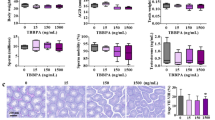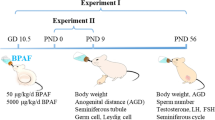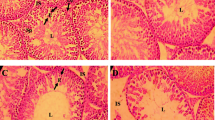Abstract
Tetrabromobisphenol A-bis(2,3-dibromopropyl ether) (TBBPA-BDBPE), a commonly used brominated flame retardant as a decabromodiphenyl ether substitute, has been detected in various environmental compartments, but its health hazards remain largely unknown. Our recent study showed that low-dose exposure of male mice to TBBPA-BDBPE from postnatal day (PND) 0 to 56 caused remarkable damage to the microtubule skeleton in Sertoli cells and the blood-testis barrier (BTB) but exerted little effect on conventional reproductive endpoints in adulthood. To investigate whether TBBPA-BDBPE may cause severe reproductive impairments at late reproductive age, here, we extended exposure of historically administrated male mice to 8-month age and allowed them to mate with non-treated females for the evaluation of fertility, followed by a general examination for the reproductive system. As expected, we found that 8-month exposure to 50 μg/kg/d as well as 1000 μg/kg/d TBBPA-BDBPE caused severe damage to the reproductive system, including reduced sperm counts, increased sperm abnormality, histological alterations of testes. Moreover, microtubule damage and BTB-related impairment were still observed following 8-month exposure. Noticeably, high-dose TBBPA-BDBPE-treated mice had fewer offspring with a female-biased sex ratio. All results show that long-term exposure to TBBPA-BDBPE caused severe reproductive impairment, including poor fertility at late reproductive age. It is therefore concluded that slight testicular injuries in early life can contribute to reproductive impairment at late reproductive age, highlighting that alterations in certain non-conventional endpoints should be noticed as well as conventional endpoints in future reproductive toxicity studies.







Similar content being viewed by others
Data availability
Data is available within the article or on request from the corresponding author.
References
Ahmed EA, de Rooij DG (2009) Staging of mouse seminiferous tubule cross-sections. Methods Mol Biol 558:263–277. https://doi.org/10.1007/978-1-60761-103-5_16
Albani E, Castellano S, Gurrieri B et al (2019) Male age: negative impact on sperm DNA fragmentation. Aging 11(9):2749–2761. https://doi.org/10.18632/aging.101946
Ali N, Harrad S, Muenhor D, Neels H, Covaci A (2011) Analytical characteristics and determination of major novel brominated flame retardants (NBFRs) in indoor dust. Anal Bioanal Chem 400(9):3073–3083. https://doi.org/10.1007/s00216-011-4966-7
Balasch J, Gratacós E (2012) Delayed childbearing: effects on fertility and the outcome of pregnancy. Curr Opin Obstet Gynecol 24(3):187–193. https://doi.org/10.1097/GCO.0b013e3283517908
Bevan C, Tyl RW, Neeper-Bradley TL et al (1997) Developmental toxicity evaluation of methyl tertiary-butyl ether (MTBE) by inhalation in mice and rabbits. J Appl Toxicol 17(Suppl 1):S21-29. https://doi.org/10.1002/(sici)1099-1263(199705)17:1+%3cs21::aid-jat407%3e3.3.co;2-5
Clapp R, Ozonoff D (2000) Where the boys aren’t: dioxin and the sex ratio. Lancet (london, England) 355(9218):1838–1839. https://doi.org/10.1016/s0140-6736(00)02280-7
Davis DL, Gottlieb MB, Stampnitzky JR (1998) Reduced ratio of male to female births in several industrial countries: a sentinel health indicator? JAMA 279(13):1018–1023. https://doi.org/10.1001/jama.279.13.1018
Davis DL, Webster P, Stainthorpe H, Chilton J, Jones L, Doi R (2007) Declines in sex ratio at birth and fetal deaths in Japan, and in U.S. whites but not African Americans. Environ Health Perspect 115(6):941–946. https://doi.org/10.1289/ehp.9540
Dobrzynska MM, Tyrkiel EJ, Gajowik A (2017) Three generation study of reproductive and developmental toxicity following exposure of pubescent F0 male mice to di-n-butyl phthalate. Mutagenesis 32(4):445–454. https://doi.org/10.1093/mutage/gex011
Dong S, Chen C, Zhang J, Gao Y, Zeng X, Zhang X (2022) Testicular aging, male fertility and beyond. Front Endocrinol (lausanne) 13:1012119. https://doi.org/10.3389/fendo.2022.1012119
EFSA Panel on Contaminants in the Food Chain (CONTAM) (2011) Scientific Opinion on Tetrabromobisphenol A (TBBPA) and its derivatives in food. EFSA J 9(12):2477. https://doi.org/10.2903/j.efsa.2011.2477
EPA (2014) An alternative assessment for the flame retardant decabromodiphenyl ether (DecaBDE)
Gaukler SM, Ruff JS, Potts WK (2016) Paroxetine exposure skews litter sex ratios in mice suggesting a Trivers-Willard process. Behav Ecol 27(4):1113–1121. https://doi.org/10.1093/beheco/arw017
Gerber J, Heinrich J, Brehm R (2016) Blood-testis barrier and Sertoli cell function: lessons from SCCx43KO mice. Reproduction 151(2):R15-27. https://doi.org/10.1530/REP-15-0366
Goldsmith JR, Potashnik G, Israeli R (1984) Reproductive outcomes in families of DBCP-exposed men. Arch Environ Health 39(2):85–89. https://doi.org/10.1080/00039896.1984.10545840
Li Y, Dong M, Xiong Y et al (2022) Effects of postnatal exposure to tetrabromobisphenol A on testis development in mice and early key events. Arch Toxicol 96(6):1881–1892. https://doi.org/10.1007/s00204-022-03259-5
Li YY, Xiong YM et al (2023) Tetrabromobisphenol A-bis(2,3-dibromopropyl ether) impairs postnatal testis development in mice: the microtubule cytoskeleton as a sensitive target. Environ Health. https://doi.org/10.1021/envhealth.3c00044
Malliari E, Kalantzi OI (2017) Children’s exposure to brominated flame retardants in indoor environments - a review. Environ Int 108:146–169. https://doi.org/10.1016/j.envint.2017.08.011
Milham S Jr (1993) Unusual sex ratio of births to carbon setter fathers. Am J Ind Med 23(5):829–831. https://doi.org/10.1002/ajim.4700230516
Mishra RK, Singh SK (2005) Effect of aqueous leaf extract of Azadirachta indica on the reproductive organs in male mice. Indian J Exp Biol 43:1093–1103
Mocarelli P, Gerthoux PM, Ferrari E et al (2000) Paternal concentrations of dioxin and sex ratio of offspring. The Lancet 355(9218):1858–1863. https://doi.org/10.1016/s0140-6736(00)02290-x
Nair AB, Jacob S (2016) A simple practice guide for dose conversion between animals and human. J Basic Clin Pharm 7(2):27–31. https://doi.org/10.4103/0976-0105.177703
Nyholm JR, Grabic R, Arp HP, Moskeland T, Andersson PL (2013) Environmental occurrence of emerging and legacy brominated flame retardants near suspected sources in Norway. Sci Total Environ 443:307–314. https://doi.org/10.1016/j.scitotenv.2012.10.081
O’Donnell L, O’Bryan MK (2014) Microtubules and spermatogenesis. Semin Cell Dev Biol 30:45–54. https://doi.org/10.1016/j.semcdb.2014.01.003
Qu G, Liu A, Wang T et al (2013) Identification of tetrabromobisphenol A allyl ether and tetrabromobisphenol A 2,3-dibromopropyl ether in the ambient environment near a manufacturing site and in mollusks at a coastal region. Environ Sci Technol 47(9):4760–4767. https://doi.org/10.1021/es3049916
Ren XM, Yao L, Xue Q et al (2020) Binding and activity of tetrabromobisphenol A mono-ether structural analogs to thyroid hormone transport proteins and receptors. Environ Health Perspect 128(10):107008. https://doi.org/10.1289/EHP6498
Rodríguez PE, Sanchez MS (2010) Maternal exposure to triclosan impairs thyroid homeostasis and female pubertal development in Wistar rat offspring. J Toxicol Environ Health A 73(24):1678–1688. https://doi.org/10.1080/15287394.2010.516241
Safdari-Dehcheshmeh F, Noroozi M, Taleghani F, Memar S (2023) Factors influencing the delay in childbearing: A narrative review. Iran J Nurs Midwifery Res 28(1):10–19. https://doi.org/10.4103/ijnmr.ijnmr_65_22
Santamaria CG, Meyer N, Schumacher A et al (2020) Dermal exposure to the UV filter benzophenone-3 during early pregnancy affects fetal growth and sex ratio of the progeny in mice. Arch Toxicol 94(8):2847–2859. https://doi.org/10.1007/s00204-020-02776-5
Shi T, Chen SJ, Luo XJ et al (2009) Occurrence of brominated flame retardants other than polybrominated diphenyl ethers in environmental and biota samples from southern China. Chemosphere 74(7):910–916. https://doi.org/10.1016/j.chemosphere.2008.10.047
Tao F, Abdallah MA, Harrad S (2016) Emerging and legacy flame retardants in UK indoor air and dust: evidence for replacement of PBDEs by emerging flame retardants? Environ Sci Technol 50(23):13052–13061. https://doi.org/10.1021/acs.est.6b02816
Tarín JJ, Brines J, Cano A (1998) Long-term effects of delayed parenthood. Hum Reprod 13(9):2371–2376. https://doi.org/10.1093/humrep/13.9.2371
Wang L, Yan M, Wu S et al (2020) Microtubule cytoskeleton and spermatogenesis-lesson from studies of toxicant models. Toxicol Sci 177(2):305–315. https://doi.org/10.1093/toxsci/kfaa109
Whorton MD, Haas JL, Trent L, Wong O (1994) Reproductive effects of sodium borates on male employees: birth rate assessment. Occup Environ Med 51(11):761–767. https://doi.org/10.1136/oem.51.11.761
Wyrobek AJ, Bruce WR (1975) Chemical induction of sperm abnormalities in mice. Proc Natl Acad Sci U S A 72(11):4425–4429. https://doi.org/10.1073/pnas.72.11.4425
Yao L, Wang Y, Shi J et al (2021) Toxicity of tetrabromobisphenol A and its derivative in the mouse liver following oral exposure at environmentally relevant levels. Environ Sci Technol 55(12):8191–8202. https://doi.org/10.1021/acs.est.1c01726
Zuiderveen EAR, Slootweg JC, de Boer J (2020) Novel brominated flame retardants - A review of their occurrence in indoor air, dust, consumer goods and food. Chemosphere 255:126816. https://doi.org/10.1016/j.chemosphere.2020.126816
Acknowledgements
This work was supported by the National Key Research and Development Program of China (2018YFA0901103) and the National Natural Science Foundation of China (42277434).
Author information
Authors and Affiliations
Contributions
YYL: Conceptualization, Methodology, Investigation, Data curation, Writing–original draft, Writing– review & editing. YMK: Investigation, Visualization. XYC: Investigation. JYS: Experiment. LL: Experiment. XHL: Supervision. ZF: Conceptualization, Project administration, Supervision, Writing– review & editing, Funding acquisition.
Corresponding author
Ethics declarations
Conflict of interest
The authors declare that there are no conflicts of interest.
Additional information
Publisher's Note
Springer Nature remains neutral with regard to jurisdictional claims in published maps and institutional affiliations.
Rights and permissions
Springer Nature or its licensor (e.g. a society or other partner) holds exclusive rights to this article under a publishing agreement with the author(s) or other rightsholder(s); author self-archiving of the accepted manuscript version of this article is solely governed by the terms of such publishing agreement and applicable law.
About this article
Cite this article
Li, YY., Xiong, YM., Chen, XY. et al. Extended exposure to tetrabromobisphenol A-bis(2,3-dibromopropyl ether) leads to subfertility in male mice at the late reproductive age. Arch Toxicol 97, 2983–2995 (2023). https://doi.org/10.1007/s00204-023-03589-y
Received:
Accepted:
Published:
Issue Date:
DOI: https://doi.org/10.1007/s00204-023-03589-y




